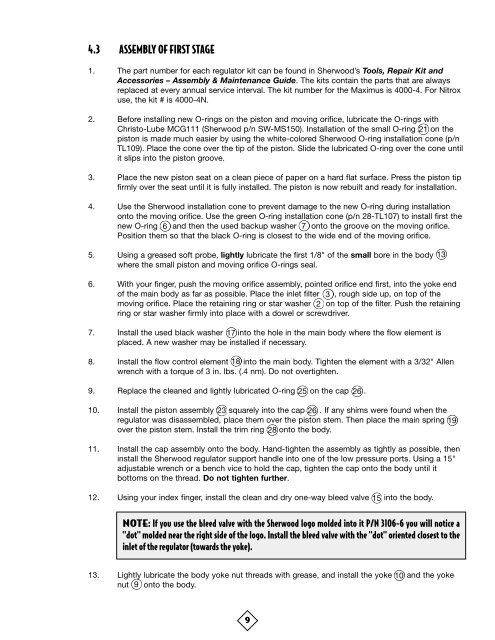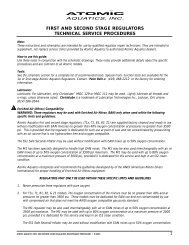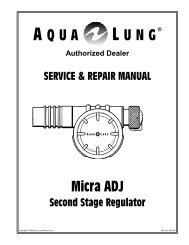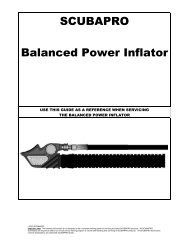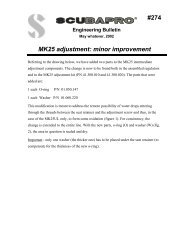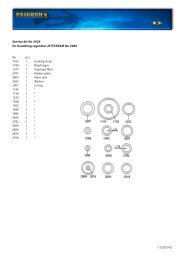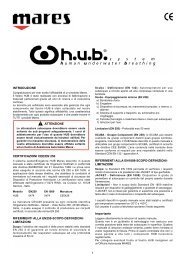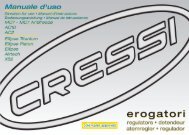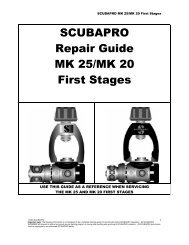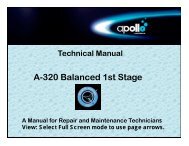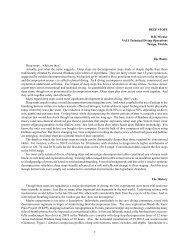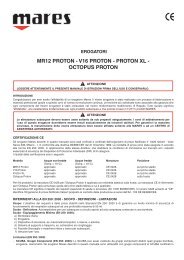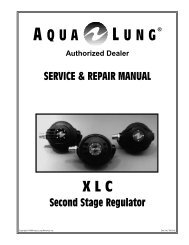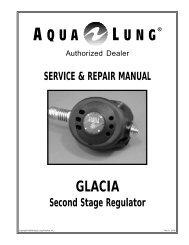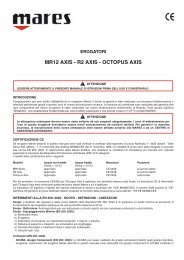SRB5600.pdf1687 KBytes - Frogkick.dk
SRB5600.pdf1687 KBytes - Frogkick.dk
SRB5600.pdf1687 KBytes - Frogkick.dk
You also want an ePaper? Increase the reach of your titles
YUMPU automatically turns print PDFs into web optimized ePapers that Google loves.
4.3 ASSEMBLY OF FIRST STAGE<br />
1. The part number for each regulator kit can be found in Sherwood’s Tools, Repair Kit and<br />
Accessories – Assembly & Maintenance Guide. The kits contain the parts that are always<br />
replaced at every annual service interval. The kit number for the Maximus is 4000-4. For Nitrox<br />
use, the kit # is 4000-4N.<br />
2. Before installing new O-rings on the piston and moving orifice, lubricate the O-rings with<br />
Christo-Lube MCG111 (Sherwood p/n SW-MS150). Installation of the small O-ring 21 on the<br />
piston is made much easier by using the white-colored Sherwood O-ring installation cone (p/n<br />
TL109). Place the cone over the tip of the piston. Slide the lubricated O-ring over the cone until<br />
it slips into the piston groove.<br />
3. Place the new piston seat on a clean piece of paper on a hard flat surface. Press the piston tip<br />
firmly over the seat until it is fully installed. The piston is now rebuilt and ready for installation.<br />
4. Use the Sherwood installation cone to prevent damage to the new O-ring during installation<br />
onto the moving orifice. Use the green O-ring installation cone (p/n 28-TL107) to install first the<br />
new O-ring 6 and then the used backup washer 7 onto the groove on the moving orifice.<br />
Position them so that the black O-ring is closest to the wide end of the moving orifice.<br />
5. Using a greased soft probe, lightly lubricate the first 1/8" of the small bore in the body<br />
where the small piston and moving orifice O-rings seal.<br />
13<br />
6. With your finger, push the moving orifice assembly, pointed orifice end first, into the yoke end<br />
of the main body as far as possible. Place the inlet filter 3 , rough side up, on top of the<br />
moving orifice. Place the retaining ring or star washer 2 on top of the filter. Push the retaining<br />
ring or star washer firmly into place with a dowel or screwdriver.<br />
7. Install the used black washer 17 into the hole in the main body where the flow element is<br />
placed. A new washer may be installed if necessary.<br />
8. Install the flow control element 18 into the main body. Tighten the element with a 3/32" Allen<br />
wrench with a torque of 3 in. lbs. (.4 nm). Do not overtighten.<br />
9. Replace the cleaned and lightly lubricated O-ring 25 on the cap 26 .<br />
10. Install the piston assembly 23 squarely into the cap 26 . If any shims were found when the<br />
regulator was disassembled, place them over the piston stem. Then place the main spring 19<br />
over the piston stem. Install the trim ring 28 onto the body.<br />
11. Install the cap assembly onto the body. Hand-tighten the assembly as tightly as possible, then<br />
install the Sherwood regulator support handle into one of the low pressure ports. Using a 15"<br />
adjustable wrench or a bench vice to hold the cap, tighten the cap onto the body until it<br />
bottoms on the thread. Do not tighten further.<br />
12. Using your index finger, install the clean and dry one-way bleed valve 15 into the body.<br />
NOTE: If you use the bleed valve with the Sherwood logo molded into it P/N 3106-6 you will notice a<br />
"dot" molded near the right side of the logo. Install the bleed valve with the "dot" oriented closest to the<br />
inlet of the regulator (towards the yoke).<br />
13. Lightly lubricate the body yoke nut threads with grease, and install the yoke 10 and the yoke<br />
nut 9 onto the body.<br />
9


